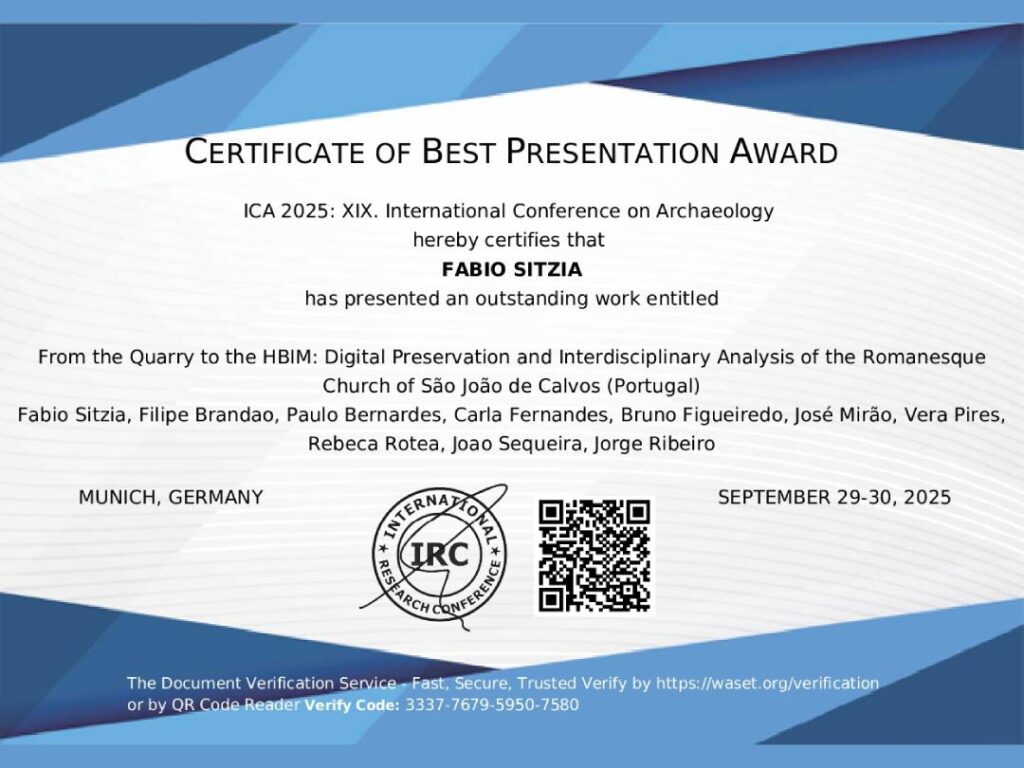Notícias
Prémio de Melhor Apresentação na ICA 2025 | Projeto exploratório "A igreja rural de estilo românico de Portugal: Um primeiro passo para a digitalização completa pelo Heritage-BIM. O caso de S. João de Calvos (Guimarães, séc. XIII d.C.)
29 a 30 de setembro de 2025 | Munique, Alemanha
Publicado a

A apresentação de Fabio Sitzia (Laboratório HERCULES – Universidade de Évora / IN2PAST), responsável pelo projeto exploratório que digitalizou a capela vimaranense com recurso a ferramentas de Heritage Building Information Modelling, resulta do trabalho desenvolvido com os/as investigadores/as do Lab2PT Bruno Figueiredo, Filipe Brandão, Jorge Ribeiro (co-IR), Paulo Bernardes e Rebeca Blanco Rotea, e também com Carla Fernandes (IHA – Instituto de História da Arte), João B. Meneses de Sequeira (CHAIA) e José Mirão e Vera Pires (HERCULES).
World Academy of Science, Engineering and Technology
International Journal of Humanities and Social Sciences
Vol:19, No:09, 2025
Authors: Fabio Sitzia, Filipe Brandão, Paulo Bernardes, Carla Fernandes, Bruno Figueiredo, José Mirão, Vera Pires, Rebeca Rotea, João Sequeira, Jorge Ribeiro
Abstract: Romanesque architecture, which flourished in Portugal during the 11th and 12th centuries, represents a pivotal era in the country’s architectural and cultural history. Romanesque-style structures, particularly rural churches, face increasing challenges due to material degradation and evolving preservation needs, necessitating innovative, multidisciplinary approaches. The Church of São João de Calvos, designated a Property of Public Interest since 1955, is a key example of Romanesque heritage. Mentioned as Sancto Johanne de Calvos in the 1220 Inquiries of King Afonso II, it is in the historic Vermuy region, which vanished during the Middle Ages. This study leverages cutting-edge digital tools to explore its architectural history and guide its preservation. This research is the first to apply a comprehensive Heritage-BIM (HBIM) protocol to São João de Calvos. Using UAV photogrammetry and laser scanning, a detailed 3D model of the church was developed, capturing exterior and interior features with high precision. Beyond geometric data, the HBIM model integrates historical, archaeological, and material analyses, offering a multidimensional resource for conservation and education. Interactive layers within the 3D reconstruction provide to data such as material decay maps of the façade and walls according to the ICCROM abacus.
Keywords: architecture, geo-materials, archaeometry, archaeological stratigraphy
Conference Title: ICA 2025 : International Conference on Archaeology
Conference Location: Munich, Germany
Conference Dates: September 29-30, 2025